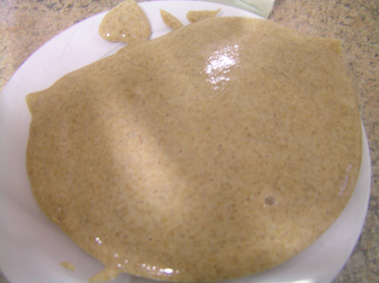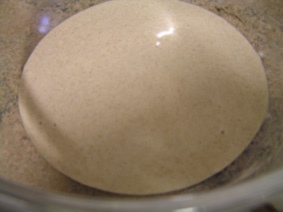My sourdough starter has arrived!
It doesn’t have a name yet, largely because all the names I come up with are things like Herbert or George, and really, sourdough starter is the mother of bread so it ought to be a girl. Geraldine, perhaps? Jocasta? Of course, the other trouble with naming it is that if I do manage to kill it I will feel even more guilty about it. Actually, I’m already feeling anticipatory guilt, because I am not at all confident of my ability to keep the baby alive…
Yesterday, I only had time to put it into the fridge, along with its siblings (it came with a dry starter and another levain, which I haven’t investigated yet – basically backup starters), but today, after feverishly reading as much of the book and the instructions as I could in the limited time available to me, I got it out of its bag before work, and fed it, in the hope that when I get home tonight, it will be sitting up and looking bubbly and healthy and ready to play.
Feeding the sourdough turns out to be fairly simple – it’s a rye starter, so one is supposed to add 50-100 grams of rye flour, and one and a half times this amount of fresh, filtered water, and then stir it vigorously until it’s all well-combined. I don’t have fresh, filtered water, so I’m hoping the bottled water won’t kill it. I also don’t have rye flour at present, so I fed it with half barley and half spelt – this will probably change the flavour slightly, but from what I can gather, it’s perfectly fine to feed your starter different flours. I’m a bit worried about the water, though. Have I poisoned my new pet?
Anyway, my starter is now sitting in a covered bowl in the kitchen, hopefully in a happy and fermentatious state. Incidentally, it’s sitting in a plastic bowl, because apparently sourdough starter has a pH of 3-4, which is quite high and will EAT THROUGH METAL. My pet has teeth! I would probably be disinclined to believe that it EATS THROUGH METAL if I had not previously made a strawberry and balsamic vinegar sorbet that tried to chew its way out of the ice-cream maker, but as things stand, I am cautious.
I’ve sent Andrew out to buy it rye flour and a water filter (this really is like adopting a pet – one needs cat-food, and kitty litter, and… On the bright side, I don’t have to register it with the counter, or make sure it has its shots, or worry about it annoying the neighbours or getting into fights, and the very last thing I want to do with it is neuter it, so perhaps not…), so that I can try for my first loaf this evening. And I’ve fed it enough that I will have leftovers to put back in the fridge to start the next loaf. It actually all seems a lot less complicated in practice than it sounded in theory.
All this photography is very well, but really, there’s only so much you can say, visually speaking, about beige goo in a bowl. It’s beige, and it’s gooey, and after feeding it is a slightly paler beige and maybe a tad runnier.
I can tell you what it smells like, though. It smells yeasty, and alcoholic, and a little beery and tangy. I tasted some and it tastes like a sharp bread liqueur – very, very tangy, very fermented, and more bread-like than bread – like an alcoholic essence of bread. With maybe a twist of lemon. I imagine what I’m tasting is the yeast (which makes bread breadish to me), the fermentation, and the acidity. I think I can taste rye in the back of it, mostly as a stronger, darker flavour to the breadish essence, but it’s hard to tell whether that flavour comes from the grain or from the fermentation.
It also turns out that sourdough starter has a sound! Or at least, it has a sound after you feed it – a faint noise between hissing and sighing, with a fizz and the occasional tiny pop from the bubbles. I know this sounds like I am hallucinating, but I’m really not – I was wandering through the kitchen to get a glass of water and I heard this very faint hiss and wondered where it was coming from (one likes to check that it is not, for example, coming from leaving a gas burner switched on with no flame). It was definitely the sourdough.
The fact that I then had to crouch down and spend five minutes listening to the sourdough is possibly not a strong indicator of sanity on my part, however. But anyone would have done the same…
7 comments for “New Pet!”
 Danika | June 10, 2011 at 11:48 am
Danika | June 10, 2011 at 11:48 am
You live in Melbourne. You will be fine giving it water from the tap. I managed to cultivate a sourdough starter from scratch that way! I didn’t know I was meant to give it filtered water. Mine only died when it wasn’t quite established and it was very very hot in the little kitchen I was using and I unexpectedly stayed out far too late and missed a feeding. 🙁
Once it’s established I understand you can be rather more laissez-faire about the whole situation.
 Catherine | June 10, 2011 at 12:30 pm
Catherine | June 10, 2011 at 12:30 pm
That’s a relief! This particular cookbook writer and purveyor of sourdough cultures is very much into organic and filtered and unbleached and so forth, and I don’t know enough to know which bits are compulsory and which bits are her particular baking fetish.
If I get mine up and running, would you like some?
 Danika | June 14, 2011 at 10:12 am
Danika | June 14, 2011 at 10:12 am
YES PLEASE! I’ve just put a refrigerator bread dough in the fridge for loaves for the next week or two, so it’ll be interesting to see how that goes.
BTW, I forgot to mention in my last comment, but I’m pretty sure the reason they tell you to use filtered water is because urban water in most cities is hard (too many minerals). Melbourne water is quite soft.
 Scott Raun | June 10, 2011 at 12:03 pm
Scott Raun | June 10, 2011 at 12:03 pm
IIRC, E. Bear calls hers a shoggoth.
 Catherine | June 10, 2011 at 12:29 pm
Catherine | June 10, 2011 at 12:29 pm
Heh, I think I’ve seen that.
I think I’ll wait to get an idea of its personality before it gets a name.
 NancyB | June 10, 2011 at 12:26 pm
NancyB | June 10, 2011 at 12:26 pm
IIRC, E. Bear calls hers a shoggoth.
 Catherine | June 10, 2011 at 12:29 pm
Catherine | June 10, 2011 at 12:29 pm
Thank you!
My culture is rye, and the book recommends 1:1.5 for rye and heavier, wholemeal flours, but 1:1 for lighter flours, which is probably the difference.



